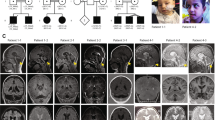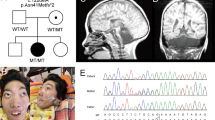Abstract
Pontocerebellar hypoplasia (PCH) is currently classified into 13 subgroups and many gene variants associated with PCH have been identified by next generation sequencing. PCH type 1 is a rare heterogeneous neurodegenerative disorder. The clinical presentation includes early-onset severe developmental delay, progressive motor neuronopathy, and cerebellar and pontine atrophy. Recently two variants in the EXOSC9 gene (MIM: 606180), NM_001034194.1: c.41T>C (p.Leu14Pro) and c.481C>T (p.Arg161*) were identified in four unrelated patients with PCH type 1D (PCH1D) (MIM: 618065). EXOSC9 encodes a component of the exosome complex, which is essential for correct processing and degradation of RNA. We report here two PCH1D families with biallelic EXOSC9 variants: c.239T>G (p.Leu80Arg) and c.484dupA (p.Arg162Lysfs*3) in one family and c.151G>C (p.Gly51Arg) in the other family. Although the patients studied here showed similar clinical features as previously described for PCH1D, relatively greater intellectual development (although still highly restricted) and normal pontine structure were recognized. Our findings expand the clinical consequences of biallelic EXOSC9 variants.
This is a preview of subscription content, access via your institution
Access options
Subscribe to this journal
Receive 12 print issues and online access
$259.00 per year
only $21.58 per issue
Buy this article
- Purchase on Springer Link
- Instant access to full article PDF
Prices may be subject to local taxes which are calculated during checkout


Similar content being viewed by others
References
van Dijk T, Baas F, Barth PG, Poll-The BT. What’s new in pontocerebellar hypoplasia? An update on genes and subtypes. Orphanet J Rare Dis. 2018;13:92.
Ivanov I, Atkinson D, Litvinenko I, Angelova L, Andonova S, Mumdjiev H, et al. Pontocerebellar hypoplasia type 1 for the neuropediatrician: genotype-phenotype correlations and diagnostic guidelines based on new cases and overview of the literature. Eur J Paediatr Neurol. 2018;22:674–81.
Morton DJ, Kuiper EG, Jones SK, Leung SW, Corbett AH, Fasken MB. The RNA exosome and RNA exosome-linked disease. Rna 2018;24:127–42.
Burns DT, Donkervoort S, Muller JS, Knierim E, Bharucha-Goebel D, Faqeih EA, et al. Variants in EXOSC9 disrupt the RNA exosome and result in cerebellar atrophy with spinal motor neuronopathy. Am J Hum Genet. 2018;102:858–73.
Miyake N, Takahashi H, Nakamura K, Isidor B, Hiraki Y, Koshimizu E, et al. Gain-of-function MN1 truncation variants cause a recognizable syndrome with craniofacial and brain abnormalities. Am J Hum Genet. 2020;106:13–25.
Bizzari S, Hamzeh AR, Mohamed M, Al-Ali MT, Bastaki F. Expanded PCH1D phenotype linked to EXOSC9 mutation. Eur J Med Genet. 2020;63:103622.
Di Donato N, Neuhann T, Kahlert AK, Klink B, Hackmann K, Neuhann I, et al. Mutations in EXOSC2 are associated with a novel syndrome characterised by retinitis pigmentosa, progressive hearing loss, premature ageing, short stature, mild intellectual disability and distinctive gestalt. J Med Genet. 2016;53:419–25.
Acknowledgements
We thank the affected individuals and their families for participating in this study. This work was supported by AMED under the grant numbers JP20ek0109280, JP20dm0107090, JP20ek0109301, and JP20ek0109348 (to N. Matsumoto); JSPS KAKENHI under the grant numbers JP17H01539 (to N. Matsumoto) and JP19H03621 (to N. Miyake); intramural grants 30-6 and 30-7 from the Ministry of Health, Labor, and Welfare (to N. Matsumoto); and the Takeda Science Foundation (to N. Matsumoto and N. Miyake). We thank Jeremy Allen, PhD, from Edanz Group (www.edanzediting.com/ac) for editing a draft of this manuscript.
Author information
Authors and Affiliations
Corresponding authors
Ethics declarations
Conflict of interest
The authors declare that they have no conflict of interest.
Additional information
Publisher’s note Springer Nature remains neutral with regard to jurisdictional claims in published maps and institutional affiliations.
Supplementary information
Rights and permissions
About this article
Cite this article
Sakamoto, M., Iwama, K., Sekiguchi, F. et al. Novel EXOSC9 variants cause pontocerebellar hypoplasia type 1D with spinal motor neuronopathy and cerebellar atrophy. J Hum Genet 66, 401–407 (2021). https://doi.org/10.1038/s10038-020-00853-2
Received:
Revised:
Accepted:
Published:
Issue Date:
DOI: https://doi.org/10.1038/s10038-020-00853-2
This article is cited by
-
Two families with TET3-related disorder showing neurodevelopmental delay with craniofacial dysmorphisms
Journal of Human Genetics (2022)
-
Amelioration of a neurodevelopmental disorder by carbamazepine in a case having a gain-of-function GRIA3 variant
Human Genetics (2022)
-
Monogenic causes of pigmentary mosaicism
Human Genetics (2022)
-
A novel LRP6 variant in a Japanese family with oligodontia
Human Genome Variation (2021)



